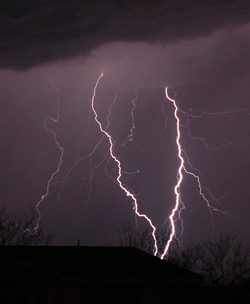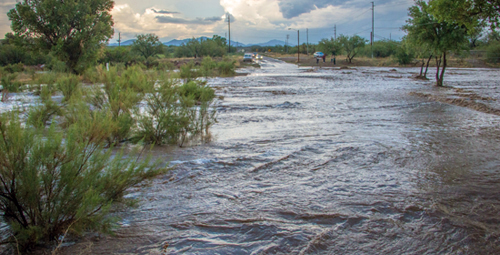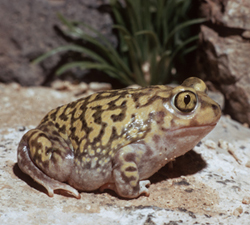
The Coati (co-AH-tee) is a relative of the raccoon with a long nose, masked face, and a striped tail. Coatis are curious and energetic, just like kids!
Coati Club News, Summer 2015
Monsoon Wash
In the Sonoran Desert, spring turns to summer. Throughout the months of May and June, heat builds. As July approaches, fluffy white clouds begin to grow in the sky and rise above the mountains like whipped cream skyscrapers. Little by little, they become dark thunderheads with millions of droplets of water. CRASH! BANG! BOOM! The deep rumble of thunder, a bolt of lightning, cool wind, and the rains of another monsoon begin.

© 2011 Liz Kemp
Heavy rains bring water from the mountains into valley washes. In Tucson, water pours down so hard that the streets look like little rivers. In a few minutes, these “little rivers” flow across the desert floor and run off into washes which have been empty and dry for months.
Quickly, the washes fill with water. Then, just as suddenly as it began, the rain is over. The sun comes out, and the sky is blue. The scent of creosote is in the air and the breeze is cooler. In a few hours, the water will sink down into the ground.
For the plants and animals whose habitat is along the wash, the storm is welcome. It brings much-needed water. Plants near the wash are greener and the cacti are swollen with stored water. But monsoon runoff can be destructive, too. It erodes the wash, sweeping away the smaller plants and even animals and their homes in its course. The animals and plants that survive all benefit from the moisture and growth along the wash habitat, however.

© 2015 Lauren G. Bailey
Coyote comes out from under a rock, shaking his wet coat. Gila woodpecker peeks out from her saguaro hole, and the songs of birds are heard everywhere. Insects crawl onto plants to dry. Tortoises are looking along the sides of the wash for their dens and javelina find comfortable, damp ground to nestle in for a nap to escape the coming heat of the day. Spadefoot toads dig out of the sand to look for rain pools where they can lay their eggs. Winged ants and termites fill the air in swirling columns like miniature tornadoes.
The wash is once again a safe path for animals to travel in search of food, water, and mates.
Toadily Awesome!

Couch's spadefoot Scaphiopus couchii
© 2007 Manny Rubio
Every year during the summer monsoon, a fantastic thing happens. On the evening of the first heavy rain, spadefoot toads dig their way up from about three feet underground and gather in pools of water left by the storms. All night, the males gather together in a noisy chorus of mating calls. Maybe you have heard them. They sound a little like sheep! (Hear their calls!)
The males and females then mate, and eggs are laid in the water. One to two days later, the eggs hatch into tadpoles. These tadpoles grow very fast, turning into toads in a few weeks, before the puddles dry up.
Throughout the summer, the toads eat enough insects to give them energy and nutrients to last a year. Then they dig burrows, using horny spades on the insides of their hind feet. They go into a deep sleep again until the next rainy season. For the spadefoot, life begins with the summer rains!
Answers:
Across: 2. Tortoise, 4. Lizard, 6. Toad, 7. Javelina, 9. Burrow, 10. mesquite Down: 1. Snake, 3. Owl, 5. Roadrunner, 8. Coyote Another word for a wash: Arroyo.

